Memorable Games, in PAW’s Words
When the Princeton Alumni Weekly began publishing in April 1900, Princeton’s football team was arguably the country’s finest, with a combined record of 23-1-1 in 1898 and 1899. (Both teams were retroactively crowned national champions by football historian Parke Davis 1893.) Football coverage became a staple of the magazine, supplementing the coverage that Tiger fans could read in the major daily newspapers. Below, browse excerpts from PAW’s coverage of 11 great games, spanning more than a century.
Nov. 14, 1903: Princeton 11, Yale 6
Captain John DeWitt, Class of 1904, and the Tigers completed Princeton’s first unbeaten, untied season since 1893. No byline accompanied the lengthy game coverage, which spanned seven of the 20 pages in PAW’s Nov. 21, 1903, issue.
The spirit that never admits defeat and the mental and physical alertness that knows how to make the most of an opportunity, both so characteristic of Princeton traditions, inspired the agile Princeton football team of 1903 to win a glorious victory at Yale Field, New Haven, on November 14th. Statisticians have figured out that Yale gained more ground both in rushing and in kicking. But it takes more than midfield rushing to make scores. The lighter Princeton team had the stuff to stop Yale’s fierce attack, to take advantage of Yale’s mistakes and, biding their time, to win out in the last two minutes of play. There were no spectators on this Princeton team.
… Captain DeWitt was the great player of the day. Besides scoring ten of Princeton’s eleven points, he was always in the thick of the fray, the most conspicuous figure on the field. He played the best guard position of the day, he did practically all of Princeton’s kicking, he ran back kick-offs, he was used to carry the ball both on fake kicks and in the tackle-back plays, he tried three goals from the field besides the place goal that was successful — all this in addition to his wonderful run of seventy-five yards for Princeton’s touchdown. After the game he sprinted off the field as though hungry for more work.
Oct. 28, 1922: Princeton 21, Chicago 18
This historic meeting that crossed regional boundaries was the first game broadcast nationally on the radio. Donald Grant Herring 1907 relied on the radio coverage to write PAW’s account of what would become known as Princeton’s “Team of Destiny”:
Oct. 28 on Stagg Field, Chicago, Princeton defeated Chicago 21-18 in one of the most thrilling games of football ever played. … Even those who watched, or rather listened to this game in Princeton (the wonders of wireless telephony were never better exemplified) were weak and trembling when, in the last few seconds of play, Chicago was held for downs less than a yard from the Princeton goal. What those who saw the game with their own eyes must have suffered I can scarcely imagine.
… This is no time for prophesy. All we can say is that both Harvard and Yale have great teams. Each of our friendly enemies has been through a hard game. But neither has been through the fire of a game such as the Princeton-Chicago contest. If anything can make a real fighting Tiger team it was that last quarter against Chicago. To come from behind and to score two touchdowns, then after taking the lead to see it almost snatched away, to fight back John Thomas and his mates right on the very goal-line, to have done these things has given the Princeton eleven a spirit they could not get in any other way.
Nov. 23, 1935: Princeton 26, Dartmouth 6
Princeton was 8-0 but still had one game remaining when Frank D. Halsey 1912 declared that the 1935 Tigers were “one of the greatest teams” in school history. His story on the Dartmouth game chronicles a test that included dreadful weather and a bizarre “12th man” play:
For those who did not see the game … it might be explained that the contest took place in a near-blizzard. Snow had begun to fall in the morning, and fell heavily from before the kick-off until after the final whistle. Although the field had been protected by tarpaulins until the last possible moment, it was dusted white before the first quarter was over, and was an inch deep with snow before the start of the second half. The temperature was expected to slow down even an unusually powerful running offense, our attack functioned beautifully.
The 12th-man play occurred in the final quarter as Princeton was nearing the end zone:
As the teams lined up for [third down], a Dartmouth adherent who had been creeping up, unobserved by players or officials, dashed forward and joined the Dartmouth line as a sort of surplus left tackle in mufti just as the play came off. His moral and physical support was unavailing, for, although [Jack] White failed to score, the ball got to the 1-yard line and White took it across easily on the next try.
Nov. 2, 1946: Princeton 17, Penn 14
Lee A. Gould ’38 reported on this upset victory — Princeton’s first at Franklin Field and the most notable win in a 3-5 season:
Battlewise Bengals, steeled by four hard games against strong opponents, spotted powerful but apparently untested Penn a couple of early touchdowns last Saturday, then fought back with ever-increasing fury to tie the score and eventually win, 17-14, on a 30-yard field goal by Kenneth Keuffel ’46, 23-year-old sophomore back and placekick artist, in the final minute of play.
It is ancient history to alumni readers now, but let it be repeated here for the record that this was the most sensational upset of the entire giddy, gaudy 1946 football season and one of the greatest in all Tiger history. It was also, mildly, one of the greatest football games ever witnessed by these or any other mortal eyes — a superb, richly deserved triumph for the unbelievably courageous, alert, inspired Princeton team, and the coaching gem of the year for Charles W. Caldwell Jr. ’25 and Assistants Cappon, Colman, and Timm.
Oct. 27, 1951: Princeton 53, Cornell 15
If there was one game that tipped the 1951 Heisman Trophy race in Dick Kazmaier ’52’s favor, it was Princeton’s midseason game against Cornell, in which Kazmaier ran for 124 yards, completed 15 of 17 passes for another 236 yards, and had a hand in five touchdowns (two rushing, three passing). Donald C. Stuart ’35 noted that Kaz “handled the ball 35 times,” averaging more than 10 yards per touch:
Fifty thousand football-loving people who filled Palmer Stadium to capacity saw a fair share of gridiron history written in startlingly bold letters on the warm autumn afternoon of October 27. In order of their importance they watched:
A completely convincing demonstration of the superior strength that the power-laden single wing affords a good team using the quick-opening T.
A beautifully-coached Princeton team, unspoiled by its long string of victories, rack up its 18th in a row with a frankly amazing 53-15 rout of previously unbeaten Cornell.
The finest individual performance in Princeton’s 82 years of football. It was, of course, credited to Dick Kazmaier.
Nov. 14, 1964: Princeton 35, Yale 14
First-place Princeton and second-place Yale faced off in front of 60,000 fans in New Haven, and Tiger star Cosmo Iacavazzi ’65 *68 did not disappoint, according to PAW’s Donald C. Stuart ’35:
As has been widely recorded in the daily press, it was the finest game in Cosmo Iacavazzi’s brilliant career. To his earlier statement that Cos stands as the best Princeton fullback of all time, Dick Colman added this thought in the postgame press conference in Lapham Fieldhouse:
“Iacavazzi is the finest running back of his kind I have ever seen in action or in motion pictures, and we screen films of teams playing from coast to coast. He adds to his extreme power a unique ability to cut at full speed without losing his balance; he spots daylight faster than any runner I ever saw, and when the other boys close on him, he just bounces off.”
Cosmo’s play in the Bowl ended a winter-long opportunity for debate between Old Blues and Old Tigers as to whether he or Chuck Mercein is the better fullback. Statistically after seven games, they were evenly matched, but on the day they played on the same field each carried the ball 20 times: Mercein totaled 88 yards and one touchdown, Iacavazzi 185 and two TDs. Not to be lost in the evaluation, either, is the fact that Cos blocks beautifully and plays a great deal of topflight defense, whereas Mercein primarily fakes when he does not carry and sees no action at all as a linebacker.
Nov. 22, 1969: Princeton 35, Dartmouth 7
When new coach Jake McCandless ’51 *52 redesigned Princeton’s offense, ditching the beloved single wing, the early results were mixed. But by season’s end, even after a loss to Yale, the Tigers had a shot at redemption — and a share of the Ivy title — in the finale against Dartmouth. David Huber ’70 covered the game for PAW:
All season long, the McCandless program has been under pressure, both subtle and unsubtle, to justify the jettison of the single wing. As quarterback Scott MacBean explained, “This was a tribute to Jake. We had humiliated ourselves on TV against Rutgers, and wanted to vindicate him on TV.”
Vindication came at the hands of outstanding individual efforts meshing so effectively that none could be called outstanding. “From the game films,” said McCandless, “we could find no weakness at all in Dartmouth. Our plan called for simply aggressive play. We had to go all the time with all we had.”
Nov. 14, 1981: Princeton 35, Yale 31
Losing to Yale in 14 straight years took its toll on Princeton fans, who rejoiced in the Tigers’ comeback victory at Palmer Stadium. Dan White ’65 described the scene:
When Princeton quarterback Bob Holly ’82 scored the winning touchdown with only four seconds remaining, balloons, confetti, paper bags, apples, hats, jackets, and other articles of clothing were flung aloft and a great noise went up over the stadium. People hugged and kissed each other. Fans left their seats and sprinted for the end zone where they mobbed the Princeton players.
Officials cleared the field for the kickoff, followed by one last desperation heave by the Bulldogs, which was intercepted. Then the celebration resumed:
The field filled quickly and the helmets of both teams soon bobbed up and down in the hugging, ecstatic milieu. The crowd went for the metal goalposts and bent them to the ground. …
Many fans lingered in the Princeton stands, some savoring the excitement, the spectacle of joyous celebration so long absent from the old stadium. Some alumni of six decades stood weeping openly. When Princeton last beat Yale in 1966, Edward Koerber ’36, an ardent supporter of Princeton football, was 52 years old and had just celebrated his 30th reunion. On this day, as he came out of the stands, now 67 years old, he could not restrain himself: “If I kick the bucket tomorrow, I’ve had a wonderful life.”
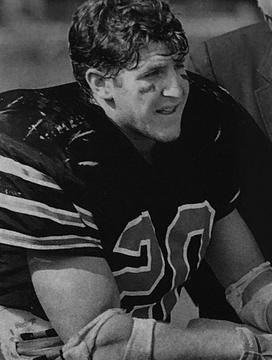
Oct. 24, 1992: Princeton 21, Harvard 6
Running back Keith Elias ’94 was a national phenomenon in his junior year, rolling over opponents until an ankle injury sidelined him for a nonconference game at Holy Cross. He stormed back the following week against Harvard. D.W. Miller ’89 covered the action:
Princeton’s prodigious son returned to electrify a crowd of 19,250 in Palmer Stadium. He inspired a 21-6 victory with two touchdowns and 155 yards rushing, which moved him within 365 yards of Judd Garrett ’90’s single-season rushing record. Confident that his achievements had generated enough glory to go around, Elias swaggered in to the postgame press conference leading his “Killer B’s” — tight end Chris Beiswenger ’93, fullback Peter Bailey ’94, and the entire offensive line, known as “the Beast.”
Elias’ return generated an early buzz from the Princeton crowd:
When he ran up the middle for fifteen yards on his first play, the crowd applauded its welcome to the tailback. And on Princeton’s next possession, when coach Steve Tosches faced a fourth down on Harvard’s two-yard line, the crowd roared its approval of his decision to go for the touchdown. Many were on their feet even before Elias hurdled a heap of bodies for a 6-0 lead.
Nov. 4, 2006: Princeton 31, Penn 30
Brett Tomlinson described the “fortuitous flip” that saved the Tigers’ Ivy title hopes:
On a fourth-and-goal play from the 1-yard line, fullback Rob Toresco ’08 tried to leap over the Quakers for a touchdown, but the defense pushed him back. He drove his legs for a second attempt, but the tacklers converged again, wrapping his ankles and waist. All that remained free was his right arm, which held the ball. When quarterback Jeff Terrell ’07 called for the ball, Toresco “turned around and just let it go,” releasing what looked like a shovel-pass in reverse.
Terrell snatched the ball and sprinted to the right side of the end zone, giving Princeton the go-ahead touchdown. Penn wasted little time in responding, scoring on the first play of its overtime possession, but the Quakers botched the point-after try due to a low snap. Princeton won, 31–30, thanks in large part to Toresco and Terrell’s sandlot-style improvisation.
After the game, the two players were all smiles when describing the play. Toresco began his account by telling reporters, “Well, the way we drew it up...” Terrell shook his head and added, “Playing in the backyard pays off sometimes.”
Oct. 20, 2012: Princeton 39, Harvard 34
In his story about Princeton closing a 24-point gap in the fourth quarter, Kevin Whitaker ’13 explained just how improbable the Tigers’ comeback was:
One online calculator says that, even after a 59-yard kick return by Anthony Gaffney ’16 gave Princeton great field position down 34–10, the Tigers had only a 2 percent chance of coming back to win. In reality, their odds were probably even lower — those calculations assume the teams are of equal strength, while Princeton and Harvard sure didn’t look evenly matched for three quarters on Saturday. “I’m glad we don’t play a seven-game series, to be honest with you, because they’re senior-led and they’re that good,” head coach Bob Surace ’90 said after his team was outgained by more than 200 yards. “We were lucky to have one more play today.”
Princeton capped its rally in the closing seconds:
Roman Wilson ’14 caught a prayer of a pass from Quinn Epperly ’15 for a 36-yard touchdown with 13 seconds left, completing a four-touchdown comeback and giving the Tigers a shocking 39–34 victory. The mood inside Princeton Stadium had gone from agony back to ecstasy. Fans stormed the field after the final whistle to celebrate the sole leaders in the league.


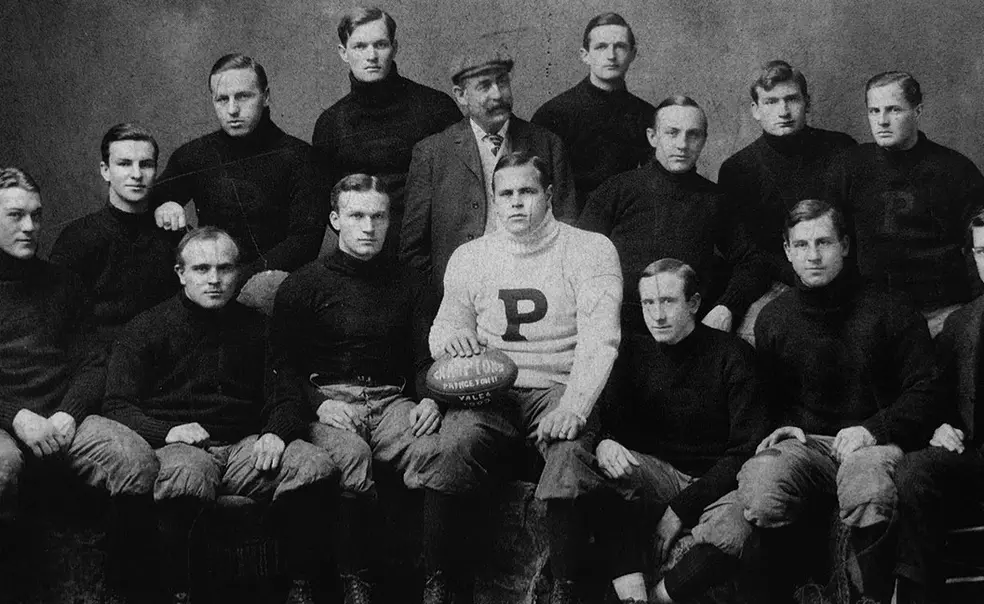
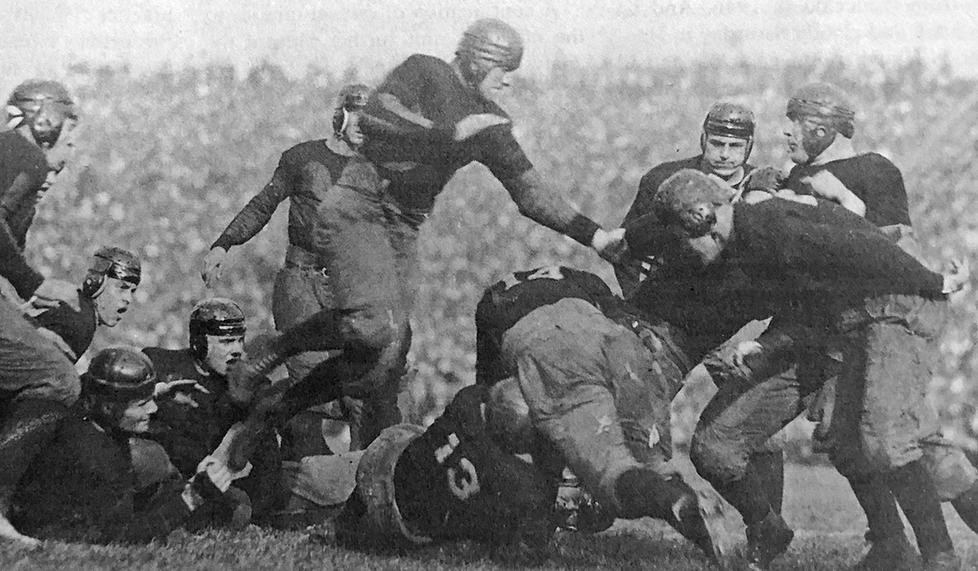

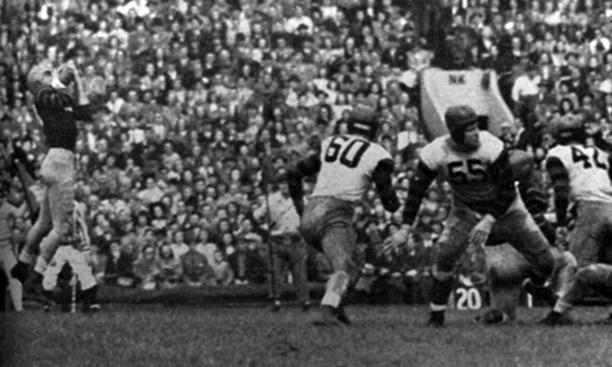

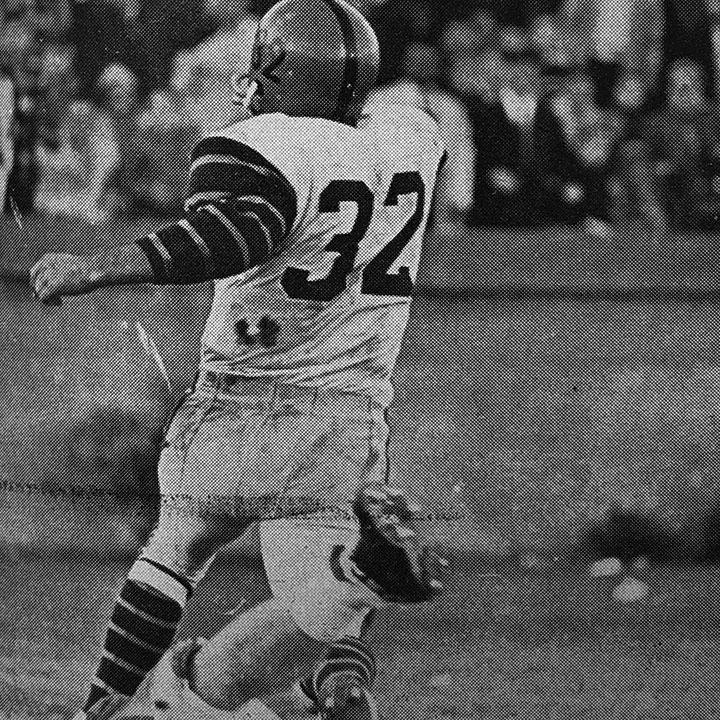
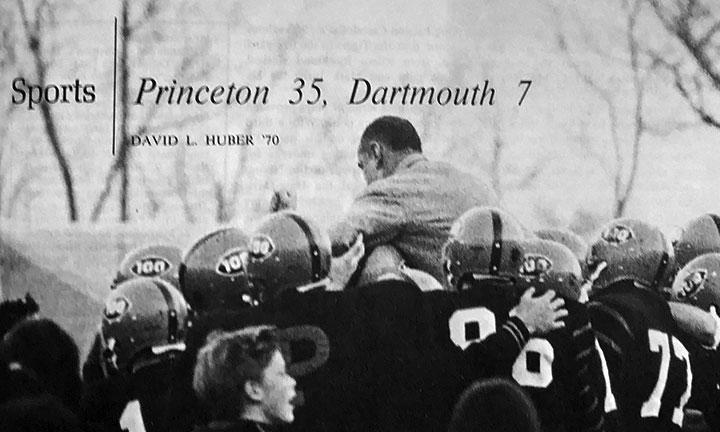
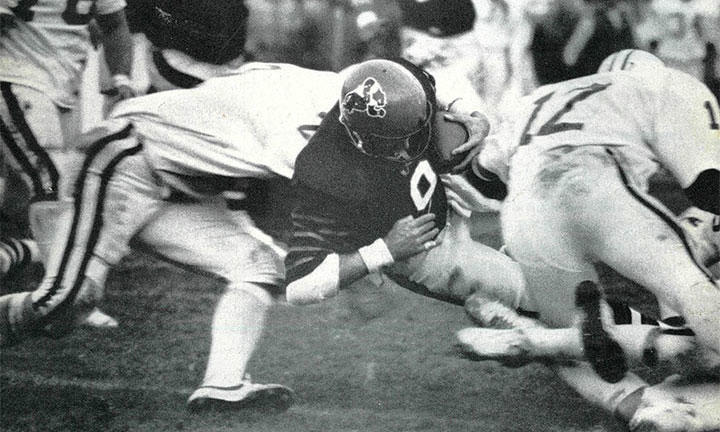

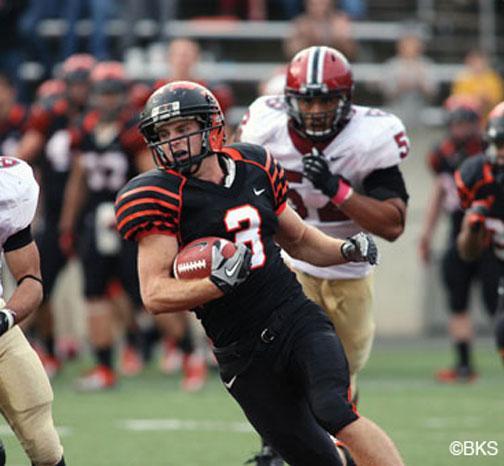









No responses yet